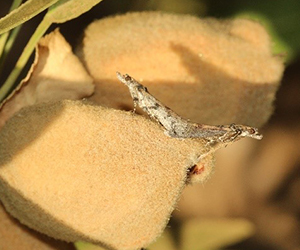The Almond Board of California (ABC) recently announced it will contribute $1 million dollars to fund a NOW Sterile Insect research project.
Navel Orangeworm (NOW) is a year-long pest that brings growers grief and worry each year and the impact of which gives handlers heartburn. Beyond the orchard floor and processing plant, NOW continues to be a problem for the industry, leading to lower returns and higher aflatoxin levels and product rejections at the port.
The Almond Board of California (ABC) has been funding NOW research for over twenty years and has made great progress in determining various production practices growers can implement for NOW control, including mating disruption, winter sanitation, the use of egg and pheromone traps and target spraying. While these practices have proven effective, this pest problem is still growing in some regions. As such, the Almond Board is taking a big step in exploring a new, viable option for NOW control.
Last month, the Almond Board of California approved the funding of $1 million dollars of a NOW Sterile Insect Technique (SIT) research project. This is the single largest production research project ever funded by the Almond Board.
 The Almond Board will contribute $1 million dollars to fund a NOW Sterile Insect research project. This is the single largest production research project funded by ABC, to date.
The Almond Board will contribute $1 million dollars to fund a NOW Sterile Insect research project. This is the single largest production research project funded by ABC, to date.
We sat down with Josette Lewis, director of Agricultural Affairs at ABC, to learn more about this novel research approach and the potential impacts it has on our industry.
ABC: What is the Sterile Insect Technique; how does it work?
Lewis: It’s all in the name: Researchers use radiation to sterilize male insects and then release them into the orchard when the first generation of mating occurs. While the physical aspect of mating still takes place, the female is not fertilized, resulting in an unproductive mating process. In the case of NOW, there can be up to four mating periods and therefore four flights throughout the year, depending on flight conditions. Sterile NOW males would be released during those flight times throughout the year, the first of which will take place shortly in the next few weeks.
ABC: How was the decision made to fund the NOW SIT research project?
Lewis: The NOW SIT opportunity first came to the Almond Board’s Pest Management Workgroup, who determined it would be beneficial to fund research in this area. They made a recommendation to ABC’s Strategic Ag Innovation Committee, who, after receiving approval from the Board of Directors, made the final decision to put $1 million towards this project.
ABC: Why is it important for the almond industry to focus on NOW, specifically?
Lewis: The Almond Board has spent decades researching NOW to better understand how growers can combat this pest and better protect their crop, and through that research we’ve made great findings. And yet, pest damage is growing due to weather changes and shifts in almond varieties.
We also know that, ultimately, controlling or even eventually eradicating NOW requires solutions that work for crops beyond the almond industry. Even if we diminish NOW damage on an annual basis in almonds, this pest will still be flying to other crops, such as pistachios and walnuts, and replenishing its population there. Therefore, taking a big picture approach to NOW control will require more of a collaborative effort with other nut industries, an effort this SIT project necessitates. Together we will test the viability of the technology to add new layers of control that work across different crops.
ABC: Are federal funds available to support the almond and pistachio industries with this project?
Lewis: Federal funds are involved in supporting the research, as well as the facilities where the sterile insects will be raised prior to their research in almond and pistachio orchards. If growers and other industry members are interested in learning more about those efforts to obtain federal funding, they can contact Elaine Trevino at the Almond Alliance for more information.
ABC: Where can growers, PCAs and other industry members learn more about this research, as well as ABC’s other projects related to NOW?
Lewis: The Almond Board of California is hosting a NOW Summit on June 18 at the Modesto Junior College Agricultural Pavilion. Speakers and an agenda are still being finalized, but this will be an event where nut growers, PCAs and others involved in California agriculture can gather to learn more about where we are with current NOW research, what problems still remain and what potential solutions lie on the horizon. One of the solutions we will discuss is this NOW SIT project, so I highly encourage all industry members to stay tuned for more information on this topic. You can subscribe to the Almond Board’s In the Orchard grower eNewsletter and check out our Almond Board calendar for more details.
If you'd like to learn more about ABC's funding of the NOW SIT project, please see our press release.